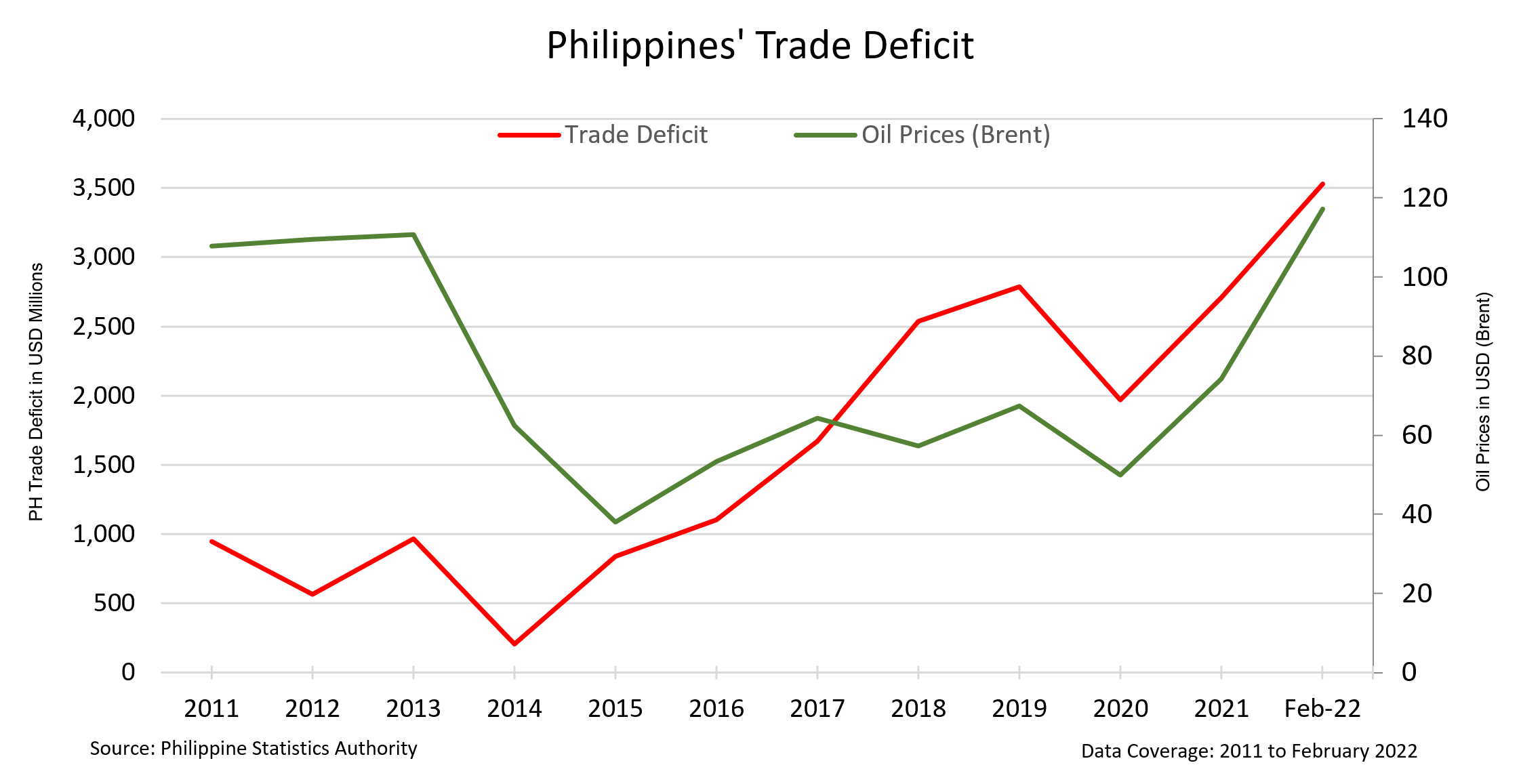MONDAY MACRO: The Philippines’ trade deficit widened by 63% and expectations are for it to increase due to the ongoing Russian-Ukraine war.

The Philippines recorded a USD 4.7 billion trade deficit in January 2022, an 11% decrease from the previous month. However, year-on-year data shows a widening of 63% in the trade deficit from January 2021.
With the Russia-Ukraine conflict already pushing up global oil prices, how will the trade deficit of a petroleum product importing country like the Philippines be affected?
Philippine Markets Newsletter:
The Monday Macro Report
Powered by Valens Research
Gross domestic product (GDP) is calculated as the sum of private consumption, gross private investment, government investment, and net export.
Net export is the difference between exports and imports. A country with a higher value of exports compared to its imports will have a higher GDP, ceteris paribus.
However, just because a country is a net exporter doesn’t mean that country is economically better off. For example, the U.S. runs one of the largest trade deficits (imports are greater than exports) in the world, and yet it is one of the best countries to invest in.
So, a widening trade deficit for the Philippines isn’t necessarily a bad thing as long as it is properly managed.
For example, though import value increased in February 2022 to USD 9.7 billion, a 20% increase from the year before, exports rose by 15% to USD 6.2 billion in the same period. This shows a roughly USD 3.5 billion trade deficit.
Six major categories recorded positive annual import growth in February 2022: mineral fuels, lubricants and related materials (132%); cereals and cereal preparations (84%); other food and live animals (23%); transport equipment (18%); electronic products (9%); plastics in primary and non-primary forms (7%).
It’s also worth noting that because of the COVID-19 pandemic, we’ve seen increases in medicinal and pharmaceutical products.
However, as the pandemic is nearing its end, the Philippines recorded a 79% decline in February 2022 versus last year for PPE (personal protective equipment) and medical supplies, and a 60% decline versus January 2022. This was largely due to the 79% decline in COVID-19 vaccine imports, from USD 303 million in January 2022 to just USD 64 million in February 2022. We can expect this number to drop as the population continues to forego booster shots.
Though electronic products still remain the largest source of imports in terms of value at USD 2.4 billion or 25% of total imports, it’s worth noting that the mineral fuels, lubricants, and related materials category grew by over 130% in February 2022.
The ongoing Ukraine-Russia conflict signals a projected swelling trade deficit for the country with the global price of oil skyrocketing to over $100 per barrel. Since the Philippines is a net importer of oil, the increase in the global price will have a domino effect in increasing the value of imports. This may further widen the country’s trade gap.
As petroleum products get more expensive, the widening trade gap may also result in further devaluation of the Philippine Peso as there will be a higher demand for the US dollar to purchase these products.
Petroleum products are found in all goods, from packaging, to energy, and manufacturing. Rising prices in petroleum products will have consequences on all industries, not just oil and energy.
About the Philippine Markets Newsletter
“The Monday Macro Report”
When just about anyone can post just about anything online, it gets increasingly difficult for an individual investor to sift through the plethora of information available.
Investors need a tool that will help them cut through any biased or misleading information and dive straight into reliable and useful data.
Every Monday, we publish an interesting chart on the Philippine economy and stock market. We highlight data that investors would normally look at, but through the lens of Uniform Accounting, a powerful tool that gets investors closer to understanding the economic reality of firms.
Understanding what kind of market we are in, what leading indicators we should be looking at, and what market expectations are, will make investing a less monumental task than finding a needle in a haystack.
Hope you’ve found this week’s macro chart interesting and insightful.
Stay tuned for next week’s Monday Macro report!
Regards,
Angelica Lim
Research Director
Philippine Markets Newsletter
Powered by Valens Research
www.valens-research.com





